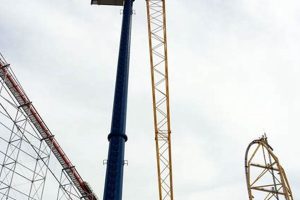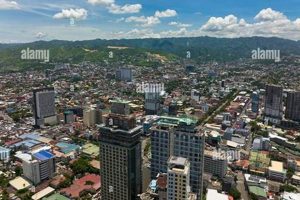The top of a skyscraper is the highest point of a building that rises several stories above the ground. Skyscrapers are often constructed in urban areas where land is scarce and there is a need for high-density housing or office space. The first skyscraper was built in Chicago in 1885, and since then, skyscrapers have become a common sight in major cities around the world.
There are many reasons why people choose to live or work in skyscrapers. For one, skyscrapers offer stunning views of the surrounding city. They can also be more energy-efficient than traditional buildings, as they are able to take advantage of natural light and ventilation. Additionally, skyscrapers can be more secure than other types of buildings, as they are often equipped with security systems and controlled access.
Of course, there are also some drawbacks to living or working in a skyscraper. One potential issue is that high-rise buildings can be more susceptible to wind damage. Additionally, elevators can be a source of inconvenience, especially during peak hours. However, despite these drawbacks, skyscrapers remain a popular choice for people who want to live or work in a high-density urban environment.
1. Height
The height of a skyscraper is one of its most defining features. The tallest skyscrapers in the world reach over 1,000 feet into the sky. This incredible height is achieved through a combination of engineering innovation and modern construction techniques.
The height of a skyscraper is important for several reasons. First, it allows the building to accommodate more people and businesses. A taller building can have more floors, which means that it can house more offices, apartments, or other types of space. Second, the height of a skyscraper can provide stunning views of the surrounding area. From the top of a tall skyscraper, you can see for miles in every direction. This can be a major selling point for businesses and residents alike.
Of course, the height of a skyscraper also comes with some challenges. One challenge is that taller buildings are more susceptible to wind damage. This is because the wind has more force to act on a taller building. Another challenge is that taller buildings can be more difficult to evacuate in the event of a fire or other emergency. However, these challenges can be overcome with careful planning and engineering.
The height of a skyscraper is a testament to human ingenuity and ambition. Skyscrapers are some of the most iconic structures in the world, and they continue to push the boundaries of what is possible in architecture and engineering.
2. Views
The views from the top of a skyscraper are some of the most breathtaking in the world. From this vantage point, you can see for miles in every direction. You can see the entire city spread out before you, like a miniature world. You can see the hustle and bustle of the streets below, and you can watch the clouds drift by overhead.It is no wonder that people are willing to pay a premium to live or work in a skyscraper with great views. In fact, some studies have shown that people who have access to natural light and views of the outdoors are more productive and have better overall well-being.The views from the top of a skyscraper can also be a source of inspiration. When you look out over the city, you can see all the possibilities that lie ahead. You can see the potential for growth and change. You can see the dreams of the people who live and work in the city.The views from the top of a skyscraper are a reminder of the power and beauty of human ambition. They are a reminder that anything is possible if you set your mind to it. They are a reminder that the sky is the limit.
Of course, the views from the top of a skyscraper come with a price. The higher you go, the more expensive the rent or mortgage will be. And, of course, there is the issue of wind. At the top of a skyscraper, the wind can be very strong. This can make it difficult to stand up or even breathe. However, most people who live or work in skyscrapers agree that the views are worth the price.
The views from the top of a skyscraper are a unique and unforgettable experience. If you ever have the opportunity to visit a skyscraper, be sure to take some time to enjoy the views. You won’t be disappointed.
3. Wind
The wind at the top of a skyscraper can be very strong. This is because there is less friction to slow the wind down as it rises higher into the atmosphere. The wind can make it difficult to stand up or even breathe. However, the wind can also be exhilarating. It is a reminder of the power of nature and the fragility of human life.
Skyscrapers are designed to withstand strong winds. However, there have been cases of skyscrapers swaying or even collapsing due to high winds. In 1968, the Hancock Tower in Boston swayed so much in the wind that it had to be evacuated. And in 2001, the World Trade Center towers collapsed after being struck by airplanes.
The wind at the top of a skyscraper can also affect the indoor environment of the building. Strong winds can cause drafts and make it difficult to heat or cool the building. This can be a problem for people who live or work in skyscrapers.
However, the wind at the top of a skyscraper can also be used to generate electricity. Wind turbines can be installed on the top of skyscrapers to harness the wind’s energy. This can help to reduce the building’s energy costs and make it more sustainable.
The wind at the top of a skyscraper is a powerful force that can have a significant impact on the building and its occupants. However, by understanding the wind and its effects, engineers can design skyscrapers that are safe and comfortable.
4. Antennas
Antennas are a vital component of any skyscraper. They are used to transmit and receive radio waves, television signals, and other types of communication. Antennas are typically located at the top of a skyscraper, where they have the best possible reception.The connection between antennas and the top of a skyscraper is essential for several reasons. First, the height of a skyscraper provides antennas with a clear line of sight to other antennas and communication towers. This allows antennas to transmit and receive signals over long distances. Second, the top of a skyscraper is often the only place where there is enough space to install large antennas. Third, the top of a skyscraper is typically the safest place to install antennas, as they are less likely to be damaged by wind or other weather conditions.
There are many different types of ant
ennas that can be installed on the top of a skyscraper. The type of antenna that is used depends on the specific communication needs of the building. For example, some antennas are used for transmitting and receiving radio waves, while others are used for transmitting and receiving television signals.Antennas are an essential part of modern communication. They allow us to stay connected with the world around us. The connection between antennas and the top of a skyscraper is essential for ensuring that we have the best possible communication signals.
Here are some real-life examples of the practical significance of antennas on top of skyscrapers:
- The Empire State Building in New York City has over 100 antennas on its top. These antennas are used for transmitting and receiving radio waves, television signals, and other types of communication.
The CN Tower in Toronto, Canada has a large antenna at its top. This antenna is used for transmitting and receiving radio waves and television signals.The Burj Khalifa in Dubai, United Arab Emirates has a large antenna at its top. This antenna is used for transmitting and receiving radio waves, television signals, and other types of communication.
These are just a few examples of the many skyscrapers around the world that have antennas on their tops. Antennas are an essential part of modern communication, and they play a vital role in keeping us connected with the world around us.
5. Observatories
Observatories are an essential part of many skyscrapers. They offer visitors stunning views of the surrounding city and are a popular tourist destination. Observatories are typically located at the top of a skyscraper, where they can provide the best possible views. In addition, observatories are often equipped with telescopes and other equipment that allow visitors to get a closer look at the city below.
There are many reasons why observatories are so popular. First, they offer a unique perspective on the city. From the top of a skyscraper, you can see for miles in every direction. You can see the hustle and bustle of the city below, and you can watch the clouds drift by overhead. Second, observatories are a great place to learn about the city. Many observatories have exhibits that tell the story of the city’s history and culture. Third, observatories are a great place to relax and enjoy the views. You can sit back and take in the scenery, or you can enjoy a meal or a drink at the observatory’s restaurant or bar.
Here are some real-life examples of the practical significance of observatories on top of skyscrapers:
- The Empire State Building in New York City has an observatory on the 86th floor. This observatory offers stunning views of the city, and it is one of the most popular tourist destinations in the world.
- The CN Tower in Toronto, Canada has an observatory on the 147th floor. This observatory offers breathtaking views of the city and Lake Ontario. It is also a popular tourist destination.
- The Burj Khalifa in Dubai, United Arab Emirates has an observatory on the 124th floor. This observatory offers panoramic views of the city and the surrounding desert. It is the highest observatory in the world.
Observatories are an important part of many skyscrapers. They offer visitors stunning views of the surrounding city and are a popular tourist destination. In addition, observatories are often equipped with telescopes and other equipment that allow visitors to get a closer look at the city below. Observatories are a great way to learn about the city, relax and enjoy the views.
6. Penthouses
Penthouses are luxury apartments that are located at the top of a skyscraper. They are typically the most expensive and exclusive apartments in the building, and they offer stunning views of the surrounding city. Penthouses are often associated with wealth and status, and they are often home to celebrities, business leaders, and other high-profile individuals.
There are many reasons why penthouses are so desirable. First, they offer unparalleled views of the city. From the top of a skyscraper, you can see for miles in every direction. You can watch the hustle and bustle of the city below, and you can enjoy the peace and quiet of your own private oasis. Second, penthouses are typically very spacious and luxurious. They often have multiple bedrooms and bathrooms, as well as a living room, dining room, and kitchen. Penthouses also often have access to private outdoor space, such as a balcony or terrace.
Of course, penthouses come with a price tag. They are typically the most expensive apartments in a building, and they can be difficult to find. However, for those who can afford it, a penthouse offers a unique and luxurious lifestyle.
Here are some real-life examples of the practical significance of penthouses on top of skyscrapers:
- The penthouse at the top of the Burj Khalifa in Dubai is the highest penthouse in the world. It is located on the 163rd floor and offers stunning views of the city. The penthouse has a private elevator, a swimming pool, and a gym.
- The penthouse at the top of the One57 skyscraper in New York City is one of the most expensive penthouses in the world. It is located on the 90th floor and offers panoramic views of Central Park and the Manhattan skyline. The penthouse has a private elevator, a wine cellar, and a library.
- The penthouse at the top of the 432 Park Avenue skyscraper in New York City is one of the most exclusive penthouses in the world. It is located on the 96th floor and offers 360-degree views of the city. The penthouse has a private elevator, a screening room, and a spa.
These are just a few examples of the many penthouses that are located at the top of skyscrapers around the world. Penthouses are a symbol of wealth and status, and they offer a unique and luxurious lifestyle.
7. Helipads
Helipads are landing pads for helicopters, typically located on the roofs of buildings. They are essential for providing quick and easy access to high-rise buildings, especially in urban areas where space is limited. The connection between helipads and the top of a skyscraper is crucial for several reasons.
- Convenience and Accessibility: Helipads located on top of skyscrapers offer unparalleled convenience for building occupants and visitors. They eliminate the need for ground-level transportation, allowing for direct access to the building from the air. This is particularly advantageous during emergencies, medical evacuations, or for high-profile individuals seeking privacy and security.
- Time-Saving: Utilizing a helipad significantly reduces travel time, especially in densely populated cities where traffic congestion is a major concern. By landing directly on the building’s rooftop, occupants can bypass ground-level delays and access their destination swiftly. This time-saving aspect is crucial for business executives, medical professionals, and other individuals who value efficiency.
- Emergency Response: Helipads play a vital role in emergency response situations. They provide a direct landing zone for medical helicopters, enabling rapid evacuation of critically ill or injured patien
ts from the building. Additionally, law enforcement and emergency services can utilize helipads for quick deployment and access to high-rise structures during crisis situations. - Security and Privacy: Helipads located on top of skyscrapers offer enhanced security and privacy for building occupants. By limiting access to the rooftop and controlling helicopter traffic, unauthorized individuals are prevented from entering the building. This added layer of security is particularly important for high-profile individuals, government officials, and businesses handling sensitive information.
In conclusion, the connection between helipads and the top of a skyscraper is of paramount importance. Helipads provide convenience, accessibility, time-saving benefits, and enhanced security, making them an integral part of modern high-rise buildings. Their presence on skyscrapers enables efficient transportation, facilitates emergency response, and ensures the safety and privacy of occupants.
8. Lightning rods
Lightning rods are metal rods that are placed on the top of a skyscraper to protect the building from lightning strikes. They work by attracting lightning strikes and then channeling the electricity into the ground. This prevents the electricity from flowing through the building and causing damage.
- Protection from lightning strikes: Lightning rods are very effective at protecting buildings from lightning strikes. In fact, they are so effective that they have been required by law in many countries for many years.
- Easy to install and maintain: Lightning rods are relatively easy to install and maintain. They can be installed on the top of a skyscraper in a matter of hours, and they require very little maintenance.
- Cost-effective: Lightning rods are a very cost-effective way to protect a building from lightning strikes. They are much less expensive than other methods of protection, such as lightning protection systems.
- Environmentally friendly: Lightning rods are an environmentally friendly way to protect a building from lightning strikes. They do not produce any harmful emissions, and they do not require the use of any chemicals.
Lightning rods are an important safety feature for any skyscraper. They are effective at protecting buildings from lightning strikes, they are easy to install and maintain, they are cost-effective, and they are environmentally friendly.
FAQs about the Top of a Skyscraper
Skyscrapers are iconic structures that dominate the skylines of major cities around the world. The top of a skyscraper offers stunning views, but it also comes with unique challenges and considerations. This FAQ section provides answers to some of the most common questions about the top of a skyscraper.
Question 1: What is the highest point of a skyscraper called?
The highest point of a skyscraper is called the pinnacle. The pinnacle can be a spire, antenna, or other architectural feature that extends above the roof of the building.
Question 2: What is the purpose of an antenna on top of a skyscraper?
Antennas on top of skyscrapers are used for transmitting and receiving radio waves and television signals. They are typically placed at the highest point of the building to ensure the best possible reception.
Question 3: Are penthouses only located at the top of skyscrapers?
No, penthouses are not only located at the top of skyscrapers. Penthouses can be located on any floor of a building, but they are often placed at the top to take advantage of the best views and privacy.
Question 4: What is the difference between a helipad and a landing pad?
A helipad is a landing pad specifically designed for helicopters. It is typically located on the roof of a building and is equipped with special equipment to guide the helicopter in for a safe landing.
Question 5: Why are lightning rods placed on top of skyscrapers?
Lightning rods are placed on top of skyscrapers to protect the building from lightning strikes. Lightning rods attract lightning and then channel the electricity into the ground, preventing it from flowing through the building and causing damage.
Question 6: Are the views from the top of a skyscraper worth the cost?
Whether or not the views from the top of a skyscraper are worth the cost is a subjective question. Some people may find the views to be breathtaking and worth the price of admission, while others may not. Ultimately, the decision of whether or not to visit the top of a skyscraper is a personal one.
The top of a skyscraper is a fascinating place that offers unique views and experiences. By understanding the different aspects of the top of a skyscraper, you can make informed decisions about whether or not to visit one.
Transition to the Next Article Section: The History of Skyscrapers
Tips for the Top of a Skyscraper
The top of a skyscraper offers stunning views and unique experiences. However, it is important to be prepared before you visit. Here are a few tips to help you make the most of your trip:
Tip 1: Check the weather forecast. The weather at the top of a skyscraper can be very different from the weather at ground level. It is important to check the weather forecast before you go and dress accordingly.
Tip 2: Book your tickets in advance. Many skyscrapers require you to book your tickets in advance. This is especially important if you are visiting during peak season. You can usually book your tickets online or by phone.
Tip 3: Arrive early. Allow yourself plenty of time to get to the skyscraper and go through security. You may also want to arrive early to get a good spot for the views.
Tip 4: Be prepared for crowds. Skyscrapers are popular tourist destinations, so be prepared for crowds. If you are visiting during peak season, you may want to consider visiting during off-peak hours.
Tip 5: Take your time. Don’t rush your visit. Take your time to enjoy the views and take plenty of pictures. You may also want to visit the gift shop or have a meal at the restaurant.
Tip 6: Be aware of your surroundings. The top of a skyscraper can be a dangerous place. Be aware of your surroundings and be careful not to lean over the edge.
Tip 7: Follow the rules. Skyscrapers have rules and regulations that you must follow. Be sure to read the rules before you visit and follow them carefully.
By following these tips, you can help ensure that you have a safe and enjoyable visit to the top of a skyscraper.
Summary of key takeaways or benefits:
- Checking the weather forecast can help you dress appropriately.
- Booking your tickets in advance can guarantee your admission, especially during peak season.
- Arriving early allows you ample time to go through security and find a good spot for the views.
- Being prepared for crowds can help you manage your expectations and avoid frustration.
- Taking your time allows you to fully enjoy the views and the experience.
- Being aware of your surroundings and following the rules can help ensure your safety.
Transition to the article’s conclusion:
Visiting the top of a skyscraper can be a truly unforgettable experience. By following these tips, you can help ensure
that your visit is safe and enjoyable.
Conclusion
The top of a skyscraper is a place of extremes. It is a place of beauty and danger, of ambition and humility. It is a place that reminds us of the power of human ingenuity and the fragility of human life.
Skyscrapers are a testament to the human spirit. They are a symbol of our ability to reach for the stars and to achieve great things. They are a reminder that anything is possible if we set our minds to it.
The next time you look up at a skyscraper, take a moment to appreciate its beauty and its significance. It is a symbol of human achievement and a reminder that anything is possible.







